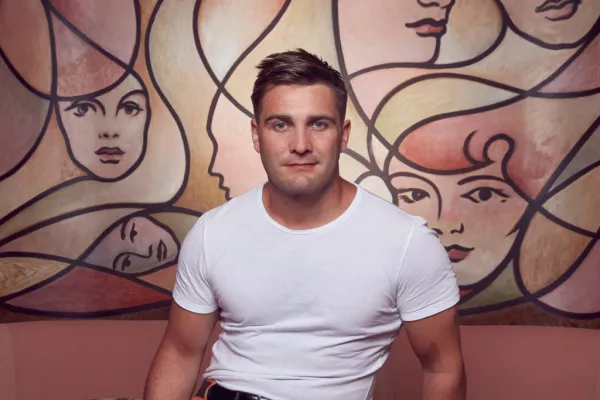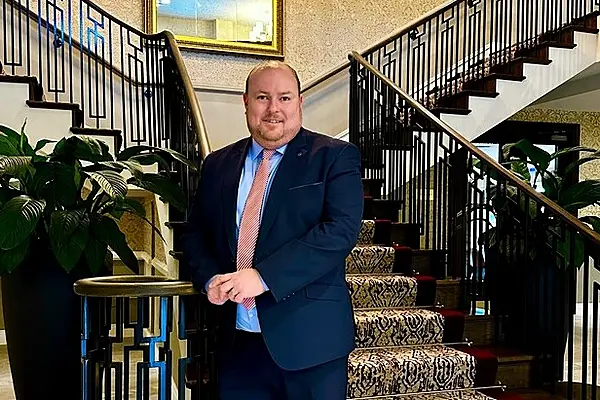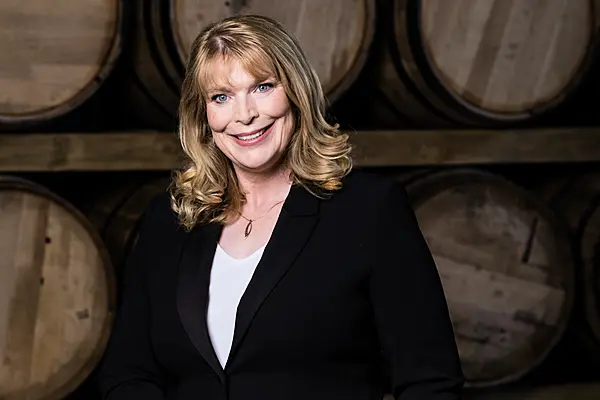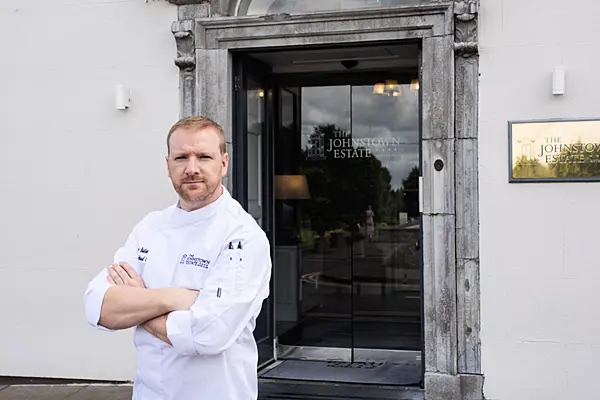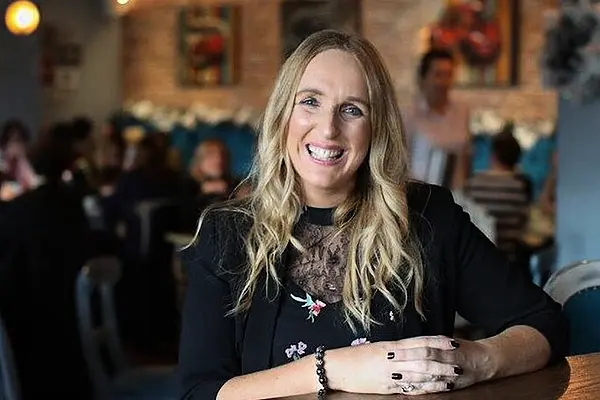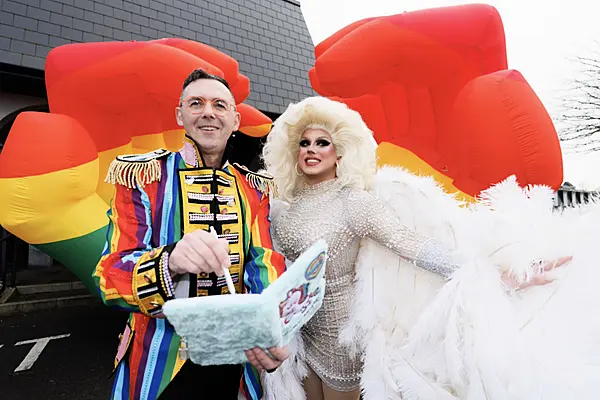Bryan O’Sullivan is the designer behind major hospitality projects including the Berkeley Bar & Terrace and Ballynahinch Castle, as well as homes, yachts, and private jets. Born in Kerry, he is also the son of legendary GAA footballer Mickey Ned O’Sullivan.
This article was originally published in the Spring 2021 issue of Hospitality Ireland Magazine, in April of 2021.
I have followed Bryan O'Sullivan's remarkable career from a distance for quite some time. His father, Mickey Ned, is a great friend to Hospitality Ireland, and has judged our National Hospitality awards many times. It was with great interest that I learned his son was making a name for himself in a notoriously difficult industry. At what stage, I ask Bryan, did he first figure out that design and interiors was what he wanted to do?
“From a very young age. My mum’s dad was a builder, but he was also kind of a self-taught designer. He used to do lots of renovations on old churches, and he would sketch out all the details – he could draw proper floor plans on drawing boards, and he had a studio in a shed off his house. I remember being obsessed with his drawings and spending loads of time with him when I was young, seeing his floor plans and all of that. That’s when I first got a taste for it. I was really into art and design. At school, which was Castleknock College, art was my favourite subject. I’d skip other classes and go to the art room. I had a really good art teacher who used to let me do that. If I got kicked out of other classes, I’d go to art class, and she’d let me sit down the back, and I’d just work on my art.”
From there, Bryan first decided that he would study architecture, “but it was about 600 points at the time, so I didn’t even apply for it,” and then switched focus for a time. “My parents were opening a new bar and restaurant in Kenmare – this was around 2000 or 2001 – and I was so into the design of that. My dad suggested I think of going into hospitality management, and, in fact, I used to chef a lot when I was younger, so I certainly had an interest in hospitality. My parents had restaurants and bars, and I had worked in them. I had also worked in Sheen Falls, cheffing, when they had a Michelin star, so you learned everything in the kitchen, the proper way.”
Bryan did a year of hospitality management in DIT Cathal Brugha Street, “but then I did a summer working in New York, on a building site down in Soho. There was an architect on the project. They were doing up an apartment building – there were to be five high-end apartments in this building – and I spent the whole summer in the office with the architect, going over all these details, and I realised, ‘I definitely want to do this.’– When I got back to Ireland in September, I broke the news to my parents that I wasn’t going back to hospitality management.” What was his parents’ response?
“They said, ‘OK, but work for a year in an architect’s office – make sure that’s what you want to do,’ so I worked for a year as an intern with Duff Tisdall, who had an architecture and interior design practice, and I loved it.”
From there, Bryan applied to the University of Greenwich and did the first part of his degree there, and the second part at the University of Westminster, with a gap year, in between, in New York.
“I worked for a lady called Annabelle Selldorf in New York. Weirdly, we’re now collaborating on a project – a hotel in the UK. She’s the architect, and we’re doing the interior.”
During the summers, while at college, Bryan worked part-time in London, at David Collins Studio, “and that’s kind of how I got into interiors from architecture. When I finished university, I worked for a year or so with him.”
What was Collins – a legendary designer who died in 2013 and did projects including Harvey’s, the Wolseley, Nobu, Harrods and Gordon Ramsay at Royal Hospital Road – like to work with?
“He was amazing. He was incredibly talented and had such design flair. He was demanding, but, I think – maybe because I was Irish – we got on well. He actually came to my graduation dinner when I graduated from university. He just had unbelievable talent, and his knowledge of what had gone before – interiors through the millennia – he had a really good understanding of the history of design. The materials he would use and the combinations – he really knew how to push the boundaries and make everything beautiful. Whatever he did looked incredible. He just got it. He knew what B looked good.”
On what kinds of projects did Bryan work?
“At the start, I was an intern, so that was during the summers of third year and fourth year, and then I was full-time when I finished university. As an intern, you’re just helping out. Then, as a junior designer, you’re put on a team and work on projects with senior designers. It’s a great way to see that world – it was a real eye-opener to follow these incredible projects. You get to go on site visits, you see how they pull presentations together for deadlines – all the stress and excitement of being in a studio.”
How did he find it?
“I really loved it. At first, when I was working there, in the back of my mind, I was like, ‘Oh, I’ll do this for a while, but I’ll eventually get back to architecture.’ The normal path with architecture would be: you do part one, part two, and then you do part three, which is the more legal stage. At first, it was in the back of my mind that I would go and do my partthree, but then I realised that my passion was way more in interiors than in architecture, and I stuck with that.”
Did he consider coming back to Ireland, or was London always the place for him?
“I think I’ve always known that London was the place. New York was the other place I lived in for a while, and I absolutely loved it. We’ve an office in New York now, so, pre-COVID, I spent a lot of time over there – once a month or once every five weeks, I’d go for a week. We have five or six projects on there at the moment. It’s such a great city – the buzz and the people and everything – but,” he hastens to add, “I love home still. I love getting back to Kenmare any time I can, and I have a site in Kenmare, just by the sea, so, eventually, I want to have my own place there. Kenmare is the one place I can go and feel totally recharged coming back from. I can switch off totally and just recharge the batteries. I can do that more there than anywhere else. Dad and I do lots of mountain-climbing or cycling, or swimming in the sea or whatever, and I just find it’s a proper break. You’re back to nature. You clear your head.”
At what point did he set up his own studio? Was it directly after working with David Collins?
“No. First I went to another London studio for about four years. Then I went to Paris for two and a half years, and then moved back to London and set up on my own then. It wasn’t fully my intention to set up on my own at that stage. A client approached me to do a project, and I said, ‘OK, I’ll do this project, and I can I dip my toe.’ I had always wanted to work for myself, but I wasn’t sure I was ready to take the plunge. This project came along, and I thought, I’ll do it, and then I’ll see. If I don’t like it, I can always look for a job again afterwards, and I never looked back after that.”
Obviously, he was able for the level of responsibility that comes with having one’s own business …?
“Yes. It’s completely consuming – it takes every part of you – and you don’t realise that beforehand. You don’t realise how much it takes and how much of your life you have to give to this, how many hours go to it – the way you never really switch your brain off in the evenings or at the weekends because you’re constantly thinking, clients can call you at any time, any day, and you have to be ready to switch on,” but he wouldn’t have it any other way.
At the moment, Bryan O’Sullivan Studio employs 20 people in London and four – soon to be five – in New York. It is, I say, a lot of responsibility.
“Yes, your payroll per month – you have to hit a certain amount every month just to pay everyone – but it’s been working out, and we’ve managed to get through COVID so far. In fact, we’ve had a really busy year. It was very scary at the start of COVID because there was a lot more uncertainty, and some of our projects went on hold for a period. Now I feel people are planning for the fact that the world is going to go back to normal soon, so they are all back on. We’ve been super-busy, which – touch wood – is great.”
Bryan’s husband, James, works with him.
“He’s commercial director, working more on the business side and keeping track of finances, so that takes a huge amount of pressure off me to think creatively because I don’t have to constantly be like, ‘Do we have enough for payroll this month?’ Having someone you trust,” he says, “to look at that side of the business so you don’t have to fully have your head in it – you can just know what’s going on, but you don’t have to be micromanaging it – is great.”
What about the pressure of working and living with your partner?
“We’ve been working together for four years,” Bryan says. “At the start, it definitely took a bit of getting used to, but we have strict rules – we’re not allowed talk about work when we get home. Also, in non-COVID times, I travelled quite a bit, so we had times of separation, in that sense. I could be travelling two or three days a week – although recently, obviously, that hasn’t been happening – but it works out. You probably have to have quite strict rules, but it’s good that James understands the stress of it, and all of that side.”
What was the first big hospitality project he did?
“I guess the one that really put us on the map was the Berkeley, but we had done some before that, down in Quinta do Lago, in Portugal. We did a restaurant called Danos, and a sport complex near it, called Campos. We had done a hotel in Cambridge called the Tamburlaine, which was one of our very early projects, but the Berkeley Bar was the first really big UK hospitality project, and it kind of opened a door for us with the Maybourne [Hotel] Group. We have so many projects with them at this stage. They’re doing a huge amount of work.
“We’re doing work in Beverly Hills, in Monaco – lots of work in their hotels in London – a new bar in the Connaught, a new bar in Claridge’s. Some are ready to go, and some are nearly finished, but I think, because of COVID, they are waiting for the right time to start opening them. They’re in a big renovation period, where they’re doing work on all their hotels. In Claridge’s, they’ve basically gone five storeys underground, and they’re adding three storeys on top and building townhouses next door. I think they’ve doubled square footage of the hotel.”
This must be an exciting time to be involved with the Maybourne Group?
“It is. We work closely with Paddy McKillen, who’s an incredible guy to work with. He has such passion for what he does, and such a good vision – he knows where to pitch it, knows where exactly it should be, and he knows how to go for it. He’s not afraid to buy into a concept or a vision.”
You need people like that in order to carry out the really big projects.
“Yes, exactly. There’s a members’ bar in Claridge’s, which we’re working on, and we’re working on two of the penthouses there as well.”
What about projects in Ireland?
“We’re still doing work at Ballynahinch Castle. We’ve done a lot of work there over the years. That’s one of my favourite projects that we’ve done. James and I actually ended up getting married in Ballynahinch, so it’s a very special place – a really magical spot. They are continuously doing parts of the hotel, keeping up to date with it. We’re also working on the Park Hotel in Kenmare, doing a big refurb. I think part of the challenge with that, like with Ballynahinch, is not to lose the essence of the hotel. You need to be able to refurbish it, but not have it feel too gleamingly new. We’re extending the dining room quite a bit. There’s a new champagne bar, there’s a refurb of the existing cocktail bar, and a new terrace out the front. It will be in keeping with the hotel, but feel a bit more up to date, with a few twists here and there. The plan was to be ready by the end of March, but it will probably be June before it can open. John [Brennan] is great to work with as well, of a similar mindset to Paddy McKillen – a real can-do go-getter, and someone who buys into the vision and is able to go for it.”
Presumably, when he’s working in Ireland, he can get home and see the family more?
“Yes, which is great, but, currently, kind of tricky with COVID. I was able to come at Christmas, and during the summer I was able to work from Kenmare. That was one positive of COVID: being able to work remotely from different locations.”
To an extent, might that continue post-COVID–?
“One of the things I have taken from COVID is that you can still work almost as successfully if you are remote, for some of the stages. It’s harder when it gets into the materials point in projects – once you need to actually start pulling fabrics like materials together, you need to have physical samples, and all of our samples are here in the library, in our studio, but I suppose you could work in such a way and plan for when that needs to happen because certainly that’s not for the whole period of the project.”
Finally, outside of work, what does he like to do? Does he play Gaelic football?
“I did when I was much younger, and I was terrible!” he laughs. “I played rugby in Castleknock, and I was good until about fourth year because I was a little bit bigger than everyone else, and then everyone caught up with me, and then I lost interest, but I do a lot of running. I’ve done a lot of triathlons over the years, half-marathons, and stuff like that. I love exercise, but I’m just not into football. I try and do something every morning – either a run or spinning. It helps me to have a clear head for the rest of the day. It helps me deal with stress. If you exercise in the morning, it just makes it easier to cope.”
Read More: Hospitality Ireland Spring 2021: Read The Latest Issue Online!
